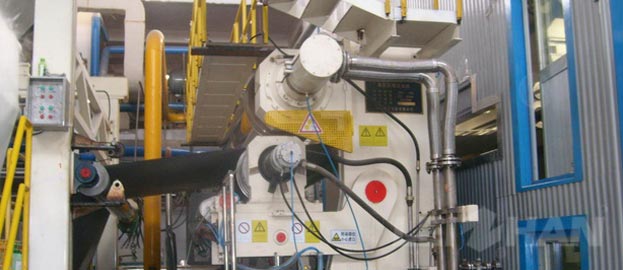
Calender, it is to use calender for certain moisture content of paper or paperboard processing, to improve the smoothness and gloss of paper, and to a certain extent, to control the thickness of paper or cardboard process. Different operation will lead to different calendering effect, therefore, how to run calender equipment efficiently?
1. The longitudinal axis of the calender roll caused by the working line pressure is deflected.
In the calendering device, when the pressurizing mechanism presses the bearings at both ends of the calendering roller, the bottom roller and the top roller are subjected to a one-way working line pressure, and the longitudinal axis thereof will generate a large bending deflection. The deflection value is proportional to the product of the roll width 4th power and the uniform power load 1st power, and the maximum deflection in the middle can reach hundreds of micrometers to several thousand micrometers, which is tens of times of the general paper thickness. This is the main reason that caused the uneven distribution of the linear pressure between the rolls and the significant changes in the finishing index of the paper’s transverse calendering.
2. Roll surface machining shape error.
The calender roll is a large-scale machined part. After the roller surface is ground, the straightness error of the busbar can reach 10-40μm, and the radial runout can reach 10-20μm, which occupies a large proportion compared with the thickness of the calendered paper.
3. Roll surface temperature deformation error.
When the calendering roller is in operation, the temperature of the roller surface will change in the horizontal direction due to uneven heating and heat dissipation. When the horizontal temperature difference of the roller surface is 10°C, the temperature deformation error of the roll surface radius can reach 17.0-45.0μm, also has a greater impact on the effect of paper finishing.
4. Local extrusion deformation error and uneven wear on contact surfaces.
Due to the uneven hardness of the roller surface, it can cause local extrusion and deformation errors on the contact surface of the calender roller, which causes the pressure between the rollers to change. After a certain period of time, partial uneven wear of the roller surface can also occur, affects the uniformity of the paper’s transverse calendering.
5. Paper thickness error.
Into the calender before the paper thickness error can generally reach its average thickness of 5% to 10%, and evenly distribute the pressure between the rollers of the calender.
If you have any requirements or questions, please leave a message, we will reply you as soon as possible!